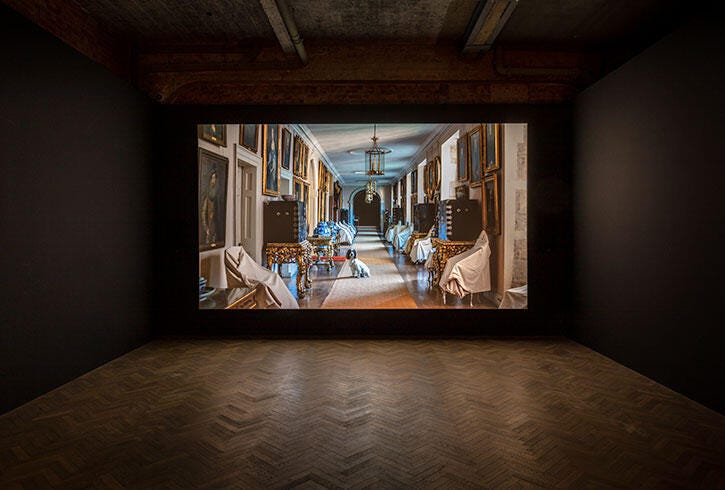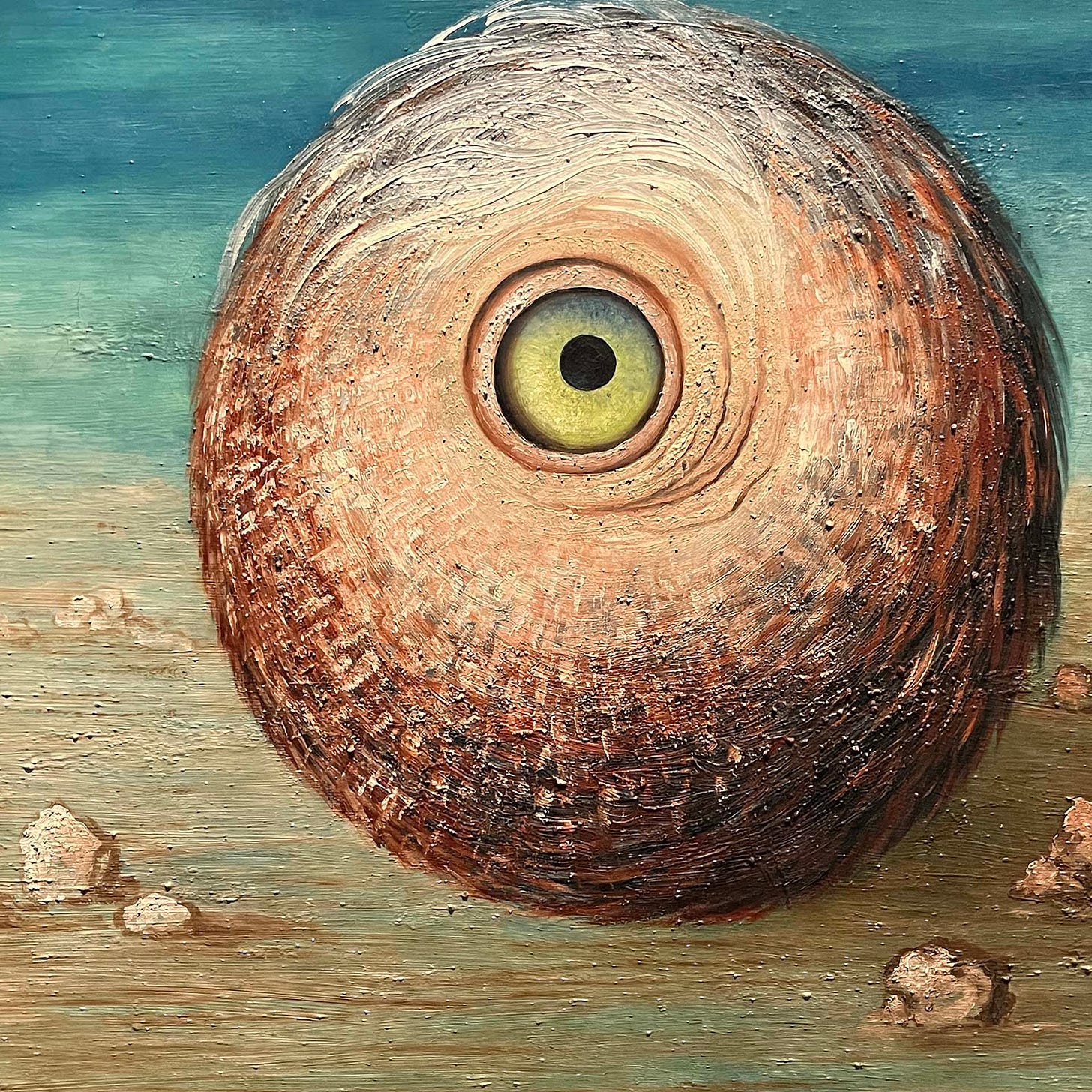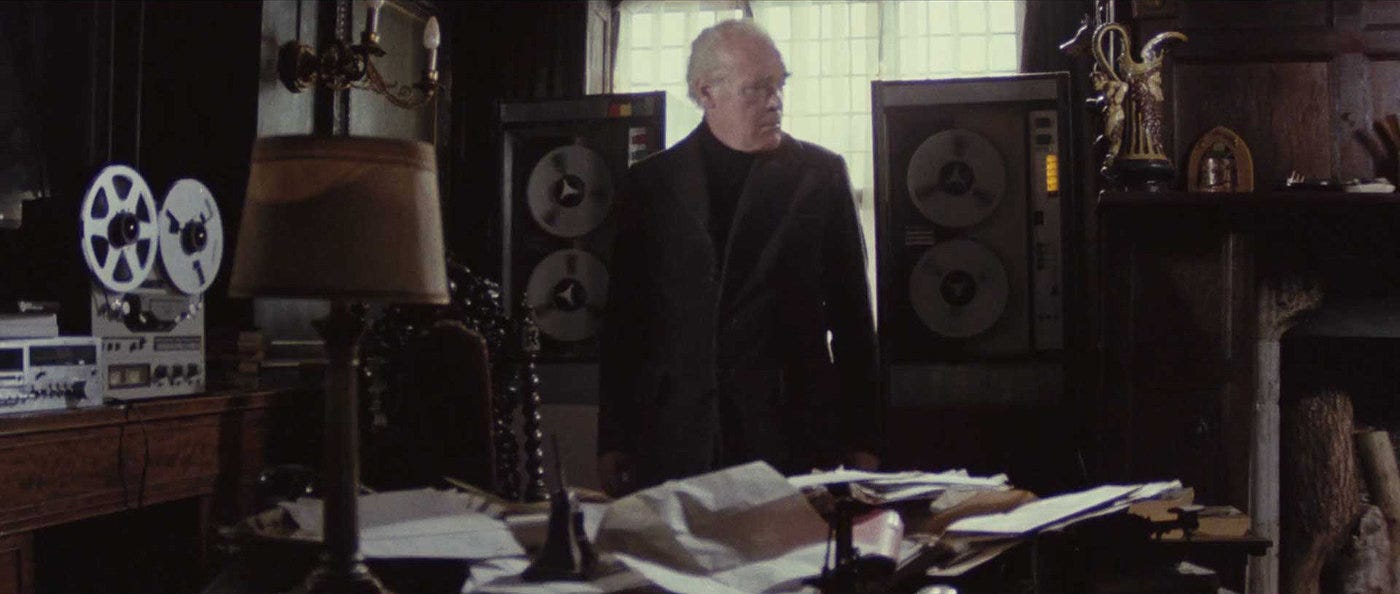Beginnings
A speaking machine, hauntings, an exhibition review, Krapp, and the actor Patrick Magee
Ladies and gentlemen, friends, readers, acquaintances, revenants…
Euphonia is a newsletter concerning my artwork and writing. Many of you already know my work, so you can anticipate what is in store: writings on experimental film, cinematic esoterica, contemporary art, horror and science fiction, and the 20th-century avant-garde. These dispatches will be at least bimonthly (twice a month), maybe weekly, but not daily. They will be looser in style than my usual published work. There will be typos—a lot of typos. As notionally conceived, these dispatches will include, in no particular order:
new texts by me, published elsewhere or exclusively here;
recent research related to artwork in progress;
photos, short videos, and visual art by me, sometimes by other people;
interviews with peers, idols, oddballs;
monthly highlights of some of the embarrassing quantities of film and art I imbibe every month;
and, yes, the occasional promotion of an exhibition or screening or Sasquatch-rare public manifestation.
All subscribers, paid and gratis, will receive all posts, however paid subscribers will have the added benefit of being patrons of the advanced arts. Please consider subscribing.
Incidentally, the Euphonia device was a 19th-century speaking machine created by the German astronomer and high-functioning melancholic, Joseph Faber. Faber worked for decades on the device, which was made up of a keyboard and organ attached to an artificial mouth, larynx, and throat. Euphonia could speak three languages and, in 1846, it performed at P.T. Barnum’s Egyptian Hall. Euphonia means “good sounding,“ though, by most earwitness accounts, it was a cursed and frightening thing. It had a “hoarse sepulchral voice… as if from the depths of a tomb.”
(You can read more about the history of speaking machines in an essay I wrote for the Guggenheim Bilbao exhibition, Architecture Effects.)
Onward, then, to what is sometimes referred to as “the content.”
Haunting
A happy few of you may have seen my film Haunting at various public forums this last year. It was an odd period to have a film circulating, especially one made during a pandemic, with various festival postponements, exhibition closures, and general plot twists. It was also an odd year to be showing a two-channel film—my first—considering some festivals opted for exclusive or partial online viewing. Haunting premiered at Lo schermo dell’arte in late 2020, and then went on to screen at HKW in Berlin and the Louvre in Paris, Palazzo Grassi in Venice, before landing at the Salzburger Kunstverein as part of the Film as Muse exhibition.
The film is not publicly streamable, but I’m making the first ten minutes available here for those who couldn’t catch it at the glamorous venues listed above. (The full runtime is about half an hour.) Enjoy.
A review and a short essay
Two of my recent texts follow. The first, a review, appeared this month on Frieze.com and will be published again later this year in the print magazine. It discusses Bloodlines, a solo exhibition by the artist Amie Siegel at Thomas Dane Gallery in London. The exhibition is excellent, and if you don’t know Amie’s work, you should.
The second piece is a short essay for Mubi’s One Shot on the career of Northern Irish actor Patrick Magee. (“One Shot is a series that seeks to find an essence of cinema history in one single image of a movie.”) Why Magee? Magee straddles my two major interests: the avant-garde and genre films. Samuel Beckett wrote Krapp’s Last Tape for Magee. Like many great UK actors, Magee spent much of his career “slumming” through low-budget horror films. It all comes together in Magee’s penultimate film: The Black Cat (1981) directed by schlockmeister Lucio Fulci, a favorite director of mine, or at least an object of longstanding fascination, who managed to get one last decent performance out of the actor. I’ll let the Mubi piece finish the thought.
Thank you for reading this far. I leave you with a photograph I took last month of a painting by Toyen at her Musee d’art Moderne retrospective in Paris. The title is of the painting is Objekt-fantom (Phantom Object or Object Phantom Eye).
See you here again soon,
J
Amie Siegel Scrutinizes Aristocratic Estates
At Thomas Dane Gallery, London, the artist explores how class domination is maintained through the conservation of objects
Originally published on Frieze.com

Is it possible to make a film in which objects are the subject of every shot? Not a film revolving around Alfred Hitchcock’s famous MacGuffin (a false object, in fact) but a film in which common, cultural objects, drive the narrative? Many films have skirted this counterintuitive project – Michael Haneke’s The Seventh Continent (1989), Chantal Akerman’s early work – but the installations of artist Amie Siegel have perhaps gone the farthest. In more than two decades of filmmaking, Siegel has documented the circulation of modernist furniture (Provenance, 2013); the afterlives of an Italian villa (Genealogies, 2016); and the cleaning of Sigmund Freud’s antiquities (Fetish, 2016). Her most recent installation, Bloodlines (2022), continues this filmography with a different cast of things. Commissioned by the National Galleries of Scotland, Bloodlines takes as its ostensible subject an exhibition of paintings by the 18th-century portraitist and equine artist, George Stubbs.
Though the Stubbs exhibition is the film’s catalyst, Bloodlines spends most of its 82 minutes in the country estates of the paintings’ aristocratic owners. These estates are enormous places, with hulking stone buildings and green grounds stretching to the horizon. The first estate we see seems abandoned to its objects: porcelain vases, gilded frames, elaborately patterned wallpaper, fake bookcases with concealed doors, chiming clocks, fireplaces and paintings hung in complex, salon-style arrangements. Some of the paintings are by Stubbs – portraits of the family’s ancestors posed at home or on horseback, surrounded by pets. Animals are everywhere, mostly domesticated and as decoration, sometimes as prey.
For the remainder of the film, people occasionally enter the frame to buff, clean, scrutinize and transport the objects. Like all good fetishes, the objects appear to move the people. We glimpse staff attempting to scrub these estates clean of the inevitable decay. The owners, whomever they might be, are not filmed or named; the usual location credits are likewise omitted. The effect is the creation of a sole, strangely generic super-estate.
The plot, as such, begins with the appearance of the art handlers. Their work sends Bloodlines into circular motion, following the paintings from the estates to the show and back. The Stubbs exhibition, when it opens, is less climax, more empty centre. We see the now-familiar works finally installed together, but the scene is a pause before the paintings are returned.
Bloodlines is as hushed as its interiors. There are no voice-overs, interviews, monologues. The film’s few conversations are overheard: art handlers (‘Up, down, okay, got it on your side?’); a portrait photographer (‘Great, that’s beautiful, find that light …’). Even an exhibition tour guide is barely audible. There is one burst of soundtrack in the film – a brief scene where an organist plays his instrument, but he stops after only a minute or two.
Siegel, from Chicago, is an outsider to this world of privilege. Despite her foreignness, her camera does not sensationalize, nor does it produce a sense of ressentiment. Bloodlines uses precise framing, deft cutting and the subtle layering of sound to construct its critique. And what is that critique? Like Stubbs, Siegel is a portraitist of power but, unlike him, she is not power’s attendant. By painting aristocrats and their pets, Stubbs gave continuity to class domination. Bloodlines shows continuity is maintained through the conservation of objects, their exhibition, circulation and inheritance. Cumulatively, the result is timelessness – a timelessness that is, of course, an illusion. Siegel shows its cracks in the peeling of wallpaper or in a curtain’s frayed edge. This is all untenable, the film says; this will all come crashing down.
Amie Siegel’s ‘Bloodlines’ is at Thomas Dane Gallery, London, until 23 July 2022.
Patrick Magee in One Shot
The stage and film actor encapsulated in one shot from Lucio Fulci's "The Black Cat."
Originally published on Mubi Notebook
It must have been a familiar scene for actor Patrick Magee. Here he was again playing an aging bachelor, surrounded by audio recording paraphernalia, listening to voices out of the past. The first time was on stage at the Royal Court Theater in 1958: a different room, different audio equipment, playing a different aging bachelor. The play was Samuel Beckett’s Krapp’s Last Tape, in which the decrepit, solitary Krapp listens to tape recordings of his younger, sometimes comically confident self. Krapp, caustic and disillusioned, has diminished since making his first recordings, growing ever more contemptuous of his youthful enthusiasms. Though the role was played by many great actors, including John Hurt, Michael Gambon, and Harold Pinter, Beckett wrote the part for Magee, or more specifically for “Magee’s distinctively Irish voice, which seemed to capture a sense of deep world-weariness, sadness, ruination, and regret.”1 During the two decades since Krapp, Magee shuttled between low and high fare, balancing Roger Corman’s Masque of the Red Death (1964) against more upmarket productions like Joseph Losey’s The Servant (1963). (For better or worse, most audiences might remember him for his role as a droog victim in 1971’s A Clockwork Orange.) But as the seventies ended, Magee’s drinking took its toll, and the number of prestige pictures dwindled. Then, one late summer in 1980, Magee again found himself alone with recording equipment, this time in the so-so horror film The Black Cat (1981) directed by Lucio Fulci, a.k.a. “the Godfather of Gore.” Magee was not Fulci’s first or even second choice for the role. Those would have been the British horror vets Peter Cushing and Donald Pleasance, both of whom turned Fulci down. It’s odd, then, that The Black Cat is so caught up with Krapp-like tape obsessions, feeling at times like a gothic Krapp Redux. Magee plays Professor Miles, a sixtyish medium and necro-audiophile who spends his evenings making electronic voice phenomena recordings at the local cemetery. (He presses “record” on his tape recorder and ghost voices take over the soundtrack.) Jaundice eyed, bad tempered, Magee’s Miles sounds as if he is in secret communication with Magee’s Krapp. Here is Miles: “That was so long ago. We can’t go back in time.” And here is Krapp: “Perhaps my best years are gone. When there was a chance of happiness.” His best years perhaps gone, Magee would appear in one more film, Docteur Jekyll et les femmes (1981), directed by yet another infamous director, Walerian Borowczyk. He would then die a year later, age sixty, leaving behind, like Krapp, an archive of youthful triumph shading into ruin.
Knowlson, James. Damned to Fame: The Life of Samuel Beckett, Grove Press, New York, 1996, p. 398.





